Introduction
How high can rabbits jump? Let’s find out.
Picture this: you’re strolling through a meadow, enjoying the sunny day, when suddenly, out of nowhere, a rabbit takes off into the sky, reaching heights you never thought possible. It’s like watching a real-life superhero in action!
What makes rabbits such incredible jumpers? Hold onto your hats, because we’re about to uncover the secrets behind their leaps.
Get ready to be amazed as we look into the mechanics of a rabbit’s jump and explore the evolutionary advantages of their high jumps. We’ll discover how these fluffy creatures use their jumping abilities to escape predators, access food, and even attract mates.
We’ll unravel the science behind their leaps, from the power of their muscles to the precision of their balance.
But that’s not all! We’ll also dig into the fascinating world of rabbit agility and sports.
It’s like watching a furry Olympics!
So, are you ready to hop into a world of excitement and discovery? Get comfortable, because we’re about to unveil the incredible evolutionary advantages and physics behind rabbits’ high jumps.
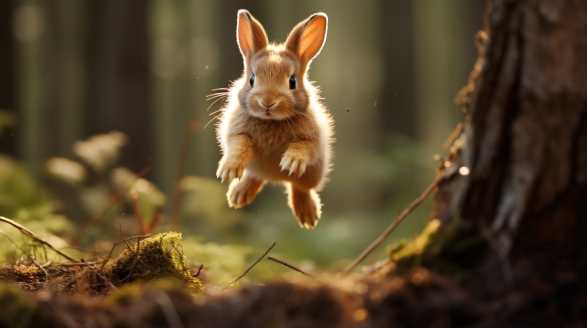
Key Takeaways
- Rabbits have remarkable jumping abilities, capable of leaping high into the air and covering impressive distances.
- The size and weight of a rabbit can influence its jumping capabilities. Smaller rabbits are often more agile and can change direction quickly, while larger rabbits have more power and can cover greater distances.
- The powerful hind legs of rabbits, along with their flexible spines and lightweight skeletal structure, contribute to their exceptional jumping prowess.
- Training and genetics also play a role in a rabbit’s jumping abilities, and regular practice can enhance their technique and overall fitness.
- Rabbits’ jumps have evolutionary advantages, including escaping predators, accessing food, and attracting mates.
- Rabbit agility competitions provide a fun and challenging way to showcase their jumping skills and build a bond between owners and their rabbits.
Leap to the Sky: Discovering the Evolutionary Advantages of Rabbits’ High Jumps
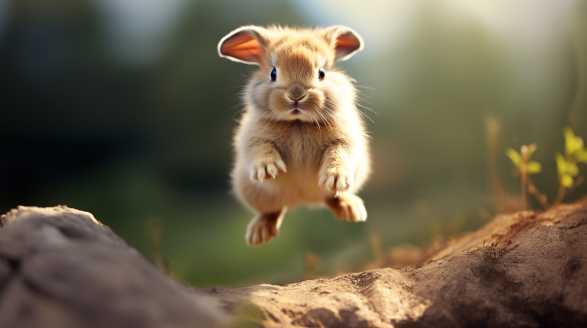
The Mechanics of a Rabbit’s Jump
Before we dive into the advantages, let’s take a moment to understand how rabbits achieve such remarkable heights. When a rabbit jumps, it pushes off the ground with its powerful hind legs.
Advantages of High Jumps for Survival
1. Escaping Predators
One of the primary advantages of rabbits’ high jumps is their ability to quickly evade predators. When faced with danger, a rabbit’s instinct is to leap as high as possible, making it harder for the predator to catch them.
2. Access to Food
Rabbits are herbivores, and a high jump can provide them with access to food that may be out of reach for other animals. By leaping onto tall bushes or over obstacles, rabbits can find fresh greens or nutritious treats that would otherwise be inaccessible.
3. Finding Mates
In the game of love, rabbits with higher jumps have an edge. Their ability to leap into the sky showcases their agility, strength, and overall fitness to potential mates.
So, those sky-high jumps aren’t just for show – they play a vital role in the continuation of rabbit species.
Evolution at Work: How Rabbits Developed Their Jumping Prowess
1. Adaptation to Habitats
Rabbits’ jumping abilities have evolved over time to match the diverse habitats they inhabit. Different habitats pose unique challenges, and only those rabbits with the ability to adapt survive.
In forests, jumping allows them to navigate obstacles such as fallen branches or rocks. This adaptability is a prime example of how evolution shapes species to conquer diverse environments.
2. Natural Selection
The concept of natural selection plays a crucial role in the evolution of rabbits’ high jumps. Over generations, rabbits with superior jumping abilities were more likely to escape predators, find abundant food, and attract mates.
Through natural selection, rabbits gradually refined their jumping skills to perfection.
3. Co-evolution with Predators
Rabbits and their predators have engaged in a never-ending evolutionary arms race. As predators adapt to catch rabbits, the rabbits, in turn, develop new strategies to escape.
The higher a rabbit can jump, the less likely it is to become the predator’s next meal. This co-evolutionary dance has led to the astonishing acrobatic abilities we observe in rabbits today.
The Physics Behind the Leaps
1. Leveraging Muscular Power
Rabbits’ hind legs act as powerful levers that allow them to generate tremendous propulsion. As they crouch down and prepare to launch, their leg muscles store energy.
The coordinated contraction of these leg muscles enables rabbits to achieve vertical take-offs and achieve impressive heights.
2. Maintaining Balance
High jumps require precise control and balance throughout the entire leap. Mid-air, rabbits use their extended forelimbs to steer and stabilize their bodies.
By actively adjusting their body position, rabbits can ensure a smooth landing and avoid injury.
Rabbits’ high jumps are not merely a spectacle, but a survival strategy honed through evolution. From escaping predators to accessing food and attracting mates, their incredible leaping abilities have proven to be indispensable.
So, the next time you spot a rabbit soaring through the sky, tip your hat to their remarkable evolutionary advantage.
How High Can a Rabbit Jump? Understanding Their Natural Abilities
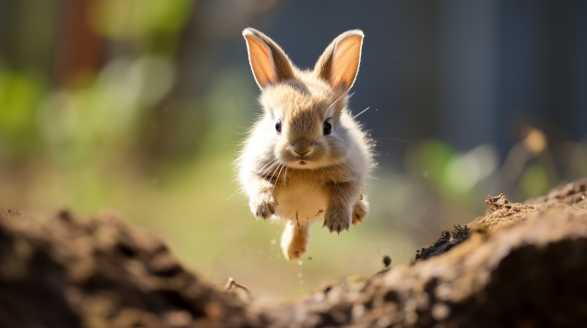
The Marvelous Muscles of a Rabbit
To understand a rabbit’s ability to jump, we must first take a closer look at their remarkable musculature. Rabbits have strong hind legs that are perfectly designed for explosive bursts of energy.
Leapin’ Legends: How High Can They Jump?
You may be wondering, just how high can a rabbit jump? Brace yourself for some astounding figures – a rabbit can typically jump up to four feet in height!
However, some rabbits with exceptional jumping prowess have been known to leap more than six feet high – that’s higher than many basketball players can even dream of reaching!
Jumping for Survival: A Matter of Life and Death
In the wild, rabbits rely on their jumping abilities for more than just clearing obstacles and impressing their fellow furry friends. These nimble creatures use their jumps as a means of evading predators and escaping danger.
The Science Behind Rabbit Jumps
Rabbit jumps are complex maneuvers that involve a combination of physical and biological factors. Let’s take a closer look at the science behind these incredible leaps:
1. Muscular Power
As mentioned earlier, a rabbit’s hind legs possess robust muscles that generate immense power. When a rabbit prepares to jump, it contracts its thigh muscles, storing energy like a coiled spring.
2. Energetic Release
Once the muscles are fully contracted, the rabbit releases that stored energy in a forceful extension of its legs. This energetic release propels the rabbit into the air, launching it to impressive heights.
3. Locomotion Control
While in mid-air, rabbits can control their body position to adjust their landing spot. By adjusting their body angle, they can precisely land where they desire, whether it’s on a higher platform or safely back on the ground.
4. Flexibility and Balance
In addition to their powerful legs, rabbits possess remarkable flexibility and balance. These traits enable them to confidently perform mid-air acrobatics, executing twists and turns with ease.
Training for Flying-Furballs: Rabbit Agility and Sports
Just like dogs participating in agility competitions, rabbits can also engage in agility training and sports. Rabbit agility involves teaching your furry friend to navigate a series of obstacles, showcasing their incredible jumping skills and coordination.
- Hoops: Rabbits learn to jump through hoops of different sizes, testing their jumping accuracy.
- Tunnels: These long, narrow tunnels challenge rabbits to navigate through them quickly and efficiently.
- Jumps: Similar to horse jumping, rabbits are trained to leap over height-adjustable jumps, demonstrating their jumping prowess.
The Upshot: Unleashing the Boundless Energy of Your Rabbit
Understanding a rabbit’s natural abilities can help you create an enriching environment and cater to their instinctual needs. Here are some ways to keep your rabbit happy, healthy, and bouncing with joy:
- Provide ample space: Rabbits love to explore and show off their jumping skills. Ensure they have a spacious, rabbit-proofed area to unleash their energetic hops.
- Offer stimulating toys: Invest in toys that encourage physical activity, such as tunnels, balls, and even small hurdles for your agile friend to conquer.
- Mental stimulation: Don’t forget to engage your rabbit’s curious mind by providing puzzle toys and hiding their favorite treats for them to search and discover.
- Social interaction: Rabbits are social creatures and thrive on companionship. Consider adopting a companion rabbit to provide a loving and stimulating environment.
Remember, understanding and respecting a rabbit’s natural abilities will foster a stronger bond and appreciation for these incredible animals. So, create an environment that allows them to truly embrace their inner athlete, and let your rabbit’s true jumping potential soar!
The Adorable Science: Why Do Rabbits Jump So High?
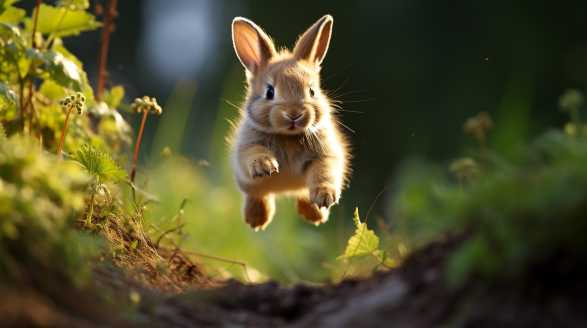
Understanding Rabbit Anatomy
Before we jump into the rabbit’s jumping prowess, let’s take a moment to appreciate their unique anatomy. Rabbits have powerful back legs that are specially designed for hopping.
The Mechanics of Rabbit Jumping
Rabbits don’t just hop like we may think; they actually jump using a combination of their hind legs and their curious anatomical structure. Let’s break it down!
Hind Leg Muscles
The hind leg muscles of rabbits are incredibly strong and built for propelling them forward. These muscles, including the gluteus and hamstring, provide the necessary power for a high jump.
Flexible Spine
Another crucial element in a rabbit’s jumping prowess is its flexible spine. Unlike humans, rabbits have an exceptionally flexible backbone.
Long Feet and Toes
Rabbits also owe their exceptional jumping prowess to their long feet and toes. These furry creatures have elongated hind feet and toes, which help them have a larger surface area to push against the ground.
The Physics Behind Rabbit Jumps
Now that we have explored the anatomical aspects of rabbits, let’s dive into the physics that play a pivotal role in their astounding jumps!
Conservation of Angular Momentum
The conservation of angular momentum is a fundamental principle of physics, and it comes into play when rabbits jump. As a rabbit leaps into the air, it tucks its forelimbs close to the body, reducing its moment of inertia.
Powerful Leg Muscles in Action
As the rabbit pushes off the ground, it contracts its powerful hind leg muscles, storing potential energy. This potential energy is quickly converted into kinetic energy when the rabbit propels itself upward, launching its body into the air like a fluffy projectile!
Muscular Strength and Contractions
The muscular strength of rabbits is truly remarkable. Their leg muscles contract rapidly, generating a significant amount of force to launch the bunny skyward.
Factors Affecting Jumping Height
While rabbits are known for their incredible jumps, it’s important to note that several factors influence their jumping height. Here are some crucial variables at play:
Size and Breed
The size and breed of a rabbit play a significant role in determining its jumping capabilities. Generally, smaller rabbits tend to be more agile and capable of higher jumps compared to larger breeds.
Fitness and Muscle Strength
Just like in humans, a rabbit’s fitness level and muscle strength greatly impact its jumping ability. Rabbits that are in good physical condition and have well-developed hind leg muscles display higher jumping prowess.
External Factors
External factors, such as the surface the rabbit is jumping from, can affect their jumping height. A solid ground surface provides better traction, allowing rabbits to effectively push against the ground.
Rabbits truly are exceptional creatures when it comes to their jumping abilities. Their powerful hind leg muscles, flexible spines, and unique anatomy all contribute to their awe-inspiring jumps.
Next time you spot a rabbit effortlessly hopping around, take a moment to marvel at their incredible skill and the adorable science behind their high jumps!
The Anatomy of a Jump: How Rabbits’ Musculoskeletal System Enables High Jumps
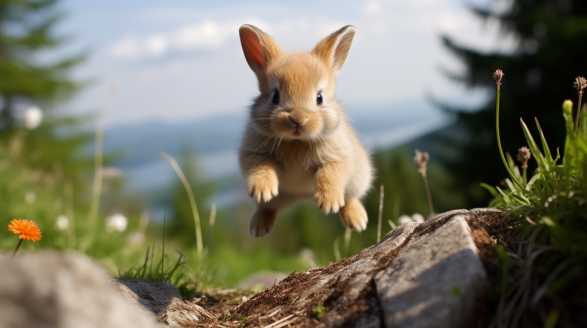
The Power of the Hind Legs
Rabbits’ hind legs are the true powerhouse behind their impressive jumps. With astonishing strength and flexibility, these limbs act as the main propellers that launch rabbits off the ground.
- Long Femurs: The long bones in a rabbit’s hind legs, known as femurs, provide a strong foundation for their jumps. These bones are significantly longer than their forelimbs, allowing for greater force and distance during propulsion.
- Powerful Muscles: The muscles in a rabbit’s hind legs are highly developed to generate the necessary force for a successful jump. The quadriceps, hamstrings, and gastrocnemius work seamlessly together, acting as powerful springs ready to launch the rabbit into the air.
- Elastic Tendons: Tendons play a crucial role in a rabbit’s jumping ability. These strong, fibrous connective tissues connect muscles to bones, allowing for efficient transmission of force. The Achilles tendon, in particular, is instrumental in storing and releasing energy like a powerful bowstring.
The Secret of Balance and Agility
Achieving great heights requires more than just powerful legs. Rabbits possess a remarkable ability to maintain balance and exhibit exceptional agility, ensuring their jumps are both accurate and graceful.
- Lightweight Skeleton: One of the secrets behind a rabbit’s agility lies in its lightweight skeletal structure. Despite having a robust musculoskeletal system, rabbits’ bones are comparatively lighter than those of larger animals, reducing the overall weight they need to propel into the air.
- Flexible Spine: A rabbit’s spine is highly flexible, allowing for quick adjustments and precise movements mid-jump. This flexibility enables rabbits to maneuver through tight spaces, change direction swiftly, and land with impressive accuracy.
- Well-coordinated Joints: Joints are essential for efficient movement, and rabbits have evolved with exceptionally coordinated joints. Their hinge-like knees and ankle joints enable them to contract and extend their limbs swiftly, maximizing the force generated during a jump.
The Graceful Landing
A successful jump is not complete without a graceful landing. Rabbits have mastered the art of landing with precision and minimal impact, ensuring their safety and well-being.
- Powerful Absorbing Pads: The bottoms of a rabbit’s paws are equipped with soft, cushion-like pads that act as shock absorbers upon landing. These pads not only minimize the impact on the joints but also provide gripping action, allowing the rabbit to maintain stability when landing on various surfaces.
- Springy Ligaments: Ligaments, the fibrous tissues that connect bones together, also play a significant role in a rabbit’s landing. Elastic ligaments in their limbs further contribute to shock absorption, reducing the strain on the bones and preventing injuries.
- Tail for Balance: While our focus has been on the musculoskeletal system, we can’t overlook the balancing factor of a rabbit’s tail. The fluffy tail acts as a counterbalance, adjusting and stabilizing the rabbit’s body during landing, ensuring a smooth and controlled return to the ground.
Rabbits’ high jumps are a marvel of nature. Their musculoskeletal system, characterized by powerful hind legs, flexibility, and agile movements, allows them to execute magnificent leaps.
So, the next time you encounter a rabbit effortlessly bounding through fields or leaping to great heights, you can appreciate the fascinating anatomy and mechanics that make it all possible.
Jumping Through Obstacles: Training Rabbits for Agility Competitions
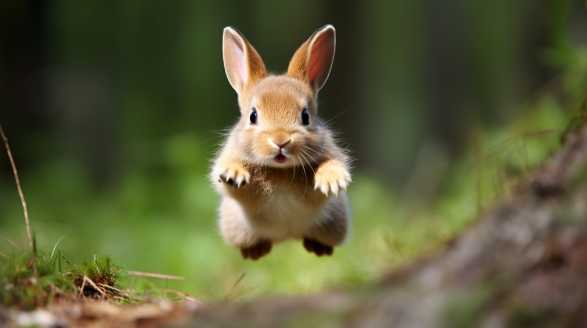
Why Agility Competitions?
Agility competitions aren’t just for dogs anymore! Rabbits are intelligent and agile animals that thrive on mental stimulation and physical exercise.
Plus, it’s loads of fun for both of you!
Getting Started: Creating a Rabbit-Friendly Course
Before diving into training, it’s essential to set up a rabbit-friendly course at home. Here’s a list of items you’ll need:
- Lightweight adjustable jumps
- Hoops
- Tunnels
- Weave poles
- A table or platform
- Non-slip flooring
- Treats and rewards
Building Trust and Bonding
Before the training begins, take some time to build trust and establish a bond with your rabbit. Spend quality time together, offering gentle strokes and positive reinforcement.
Warming Up: Daily Exercises
Just like any athlete, rabbits need to warm up before agility training. Incorporate daily exercises into your rabbit’s routine to prepare their muscles and joints for the challenges ahead.
- Bunny Hops: Encourage your rabbit to jump over small obstacles like cushions or low hurdles.
- Circle Runs: Create a circle using cones or other markers and encourage your rabbit to run around it.
- Tunnel Time: Introduce your rabbit to tunnels by starting with short ones and gradually increasing the length.
Basic Commands: The Building Blocks of Agility Training
To effectively train your rabbit for agility competitions, it’s crucial to teach them basic commands. Here are three essential commands to focus on:
- “Jump”: Teach your rabbit to jump over hurdles or through hoops by using verbal commands and hand signals. Pair each successful jump with treats and praise.
- “Weave”: Practice weaving through poles or cones. Start with a clear path and gradually decrease the gap between them.
- “Table Up”: Train your rabbit to jump onto a platform or table and stay there until given the command to jump down. This command will come in handy during competitions.
Training Techniques: Taking It to the Next Level
Once your rabbit has mastered the basic commands, it’s time to introduce more advanced training techniques. Here are a few to consider:
- Obstacle Sequencing: Begin linking different obstacles together, creating a flowing sequence. Reward your rabbit with treats and praise for completing the sequence flawlessly.
- Time Trials: Set up a small timed course and challenge your rabbit to complete it as quickly as possible. This will enhance their speed and agility while increasing their competitive spirit.
- Distraction Training: Gradually introduce distractions while training, such as toys or noises, to help your rabbit stay focused under pressure.
Safety First: Protecting Your Rabbit
When participating in agility competitions, the safety of your rabbit should be a top priority. Keep these safety tips in mind:
- Ensure that all obstacles are stable and secure to prevent any accidents.
- Use non-slip flooring to provide better traction for your rabbit.
- Don’t force your rabbit to participate or push them beyond their limits. Respect their body language and always prioritize their well-being.
The Big Day: Competing in Agility Competitions
Finally, the time has come to put your training to the test by competing in agility competitions. Here are a few important tips for a successful competition experience:
- Arrive Early: Give yourself and your rabbit plenty of time to acclimate to the surroundings and warm up before the event.
- Stay Positive: Maintain a calm and positive attitude throughout the competition to keep your rabbit relaxed and focused.
- Celebrate Achievements: Win or lose, remember to celebrate every small achievement with your rabbit. Your bond and shared experiences are what truly matter.
Training rabbits for agility competitions is a adventure that will enrich both your lives. By building trust, mastering basic commands, and implementing advanced training techniques, you and your rabbit will be ready to conquer any course.
Happy jumping!
7 Fascinating Facts About Rabbits’ Jumping Heights
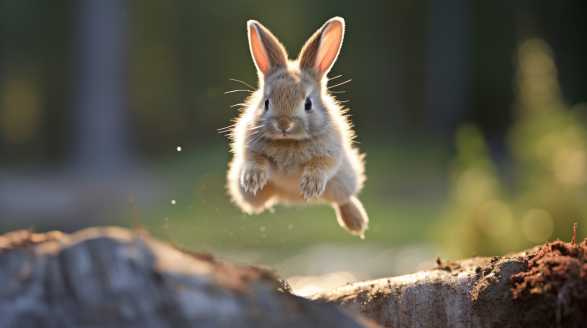
Incredibly High Leap Records
1. The Long Jump Champions
Imagine witnessing a rabbit launching itself into the air and covering an incredible distance. Well, rabbits hold the record for the long jump among all rodents.
It’s truly to think that a bunny can jump from one end of a room to the other in a single leap.
2. Vertical Jumping Heights
Rabbits are not only masters of horizontal leaps but also vertical ascents. These talented hoppers can jump up to 3 feet vertically, which is about four times their height!
It’s like witnessing a real-life superhero in action!
Tailored for Jumping
Rabbits possess a unique set of physical traits, perfectly designed to enhance their jumping skills.
3. Powerful Hind Legs
The hind legs of rabbits are exceptionally muscular, enabling them to generate immense power for their jumps. These sturdy limbs act as springs, propelling the rabbit upwards with incredible force.
4. Light and Agile Body
In addition to powerful hind legs, rabbits have lightweight bodies that complement their jumping prowess. Their skeletal structure, consisting of lightweight and hollow bones, reduces unnecessary weight, allowing the bunnies to achieve remarkable heights effortlessly.
The Science behind Their Leaps
Now, let’s look into the scientific explanations regarding rabbits’ incredible jumping abilities.
5. Muscle Mechanics at Play
Rabbits utilize a fascinating technique called “eccentric muscle contraction” to maximize their jump heights. By contracting their leg muscles before making their leap, they stretch them like springs.
6. Remarkable Balance and Coordination
To execute their jumps with precision, rabbits rely on their exceptional balance and coordination. They seamlessly adjust their body posture mid-air, making split-second decisions about the trajectory and landing spot.
Variations in Jumping Skills
Interestingly, different rabbit breeds exhibit varying levels of jumping expertise.
7. World Champion Jumpers
Some rabbit breeds excel in the art of leaping. Take the Belgian Hare breed, for example; they are renowned for their exceptional jumping capabilities.
It’s truly awe-inspiring to witness these champions in action.
8. Individual Differences
However, it’s important to note that not all rabbits possess extraordinary jumping abilities. Individual variation in genetics, physical characteristics, or even motivation can affect a rabbit’s jumping potential.
Awe-Inspiring Jumping Fun
Witnessing rabbits’ extraordinary jumping abilities can be downright entertaining and mesmerizing. It’s no wonder rabbits have captured the hearts of so many people worldwide.
Whether it’s watching them navigate an obstacle course or witnessing their joyful leaps in the great outdoors, rabbits never cease to amaze with their burst of energy and fantastic jumping skills. Their acrobatic feats will leave you in awe and bring a smile to your face.
So the next time you spot a fluffy little bunny, take a moment to appreciate their impressive jumping heights and the fascinating natural abilities they possess. These endearing creatures truly represent the beauty and wonder of the animal kingdom.
Imagine a world where rabbits soar through the sky like superheroes, their jumps reaching incredible heights. Well, believe it or not, there is a world record for the highest jump by a rabbit ever recorded, and it will surely leave you in awe.
The Rabbit’s Ascent
Setting the Stage
Rabbits are known for their agility and quick movements, but their ability to jump is truly remarkable. These adorable creatures possess powerful hind legs that allow them to leap to extraordinary heights with ease.
The Record-Breaking Leap
The astounding rabbit we’re talking about is named Snickers, a sprightly little friend who defied all expectations. On a sunny afternoon, Snickers made a leap that would forever be etched in the annals of rabbit history.
Yes, you read that right – a rabbit soared into the sky, shattering all previous records!
Previous Records Blueprints
An Admirable History
Before Snickers came along, the world record for the highest jump by a rabbit had been held by Hopper, an amazing bunny who achieved a jump of 3 feet and 5 inches. Hopper’s jump was nothing short of extraordinary and had left everyone wondering if it could ever be surpassed.
The Rise of a Champion
Snickers had always been an energetic and curious rabbit, constantly pushing the boundaries of his small world. From an early age, he displayed a flair for jumping, easily surpassing the abilities of his fellow bunnies.
The Rabbit’s Secret Weapon
The Power Behind the Leap
But what is it that allows rabbits like Snickers to defy gravity and achieve such incredible heights? The secret lies in a unique musculoskeletal system that has evolved over centuries.
- Hind Leg Muscles: The muscles in a rabbit’s hind legs are incredibly powerful, generating the force needed to propel the animal into the air.
- Long and Flexible Spine: A rabbit’s long, flexible spine acts as a spring, storing and releasing energy during the jumping motion.
- Strong and Efficient Skeletal Structure: Rabbits have a lightweight yet sturdy skeletal structure, allowing them to jump without putting excessive strain on their bodies.
How Snickers Surpassed All Expectations
Snickers was no ordinary rabbit. He possessed an unparalleled drive to push beyond previous limitations and achieve greatness.
1. Rigorous Training
Bob and Lisa recognized Snickers’ potential early on and invested time and effort into his training. They created a special obstacle course, complete with hurdles and high jumps, to challenge him and hone his skills.
2. A Nutritious Diet
To perform at his peak, Snickers needed a balanced and nutritious diet. Bob and Lisa ensured that his meals were packed with fresh greens, hay, and rabbit pellets to provide the optimal nutrition for his active lifestyle.
3. Unwavering Support
Bob and Lisa’s unwavering love and belief in Snickers played a significant role in his success. They encouraged him during moments of doubt, celebrated his victories, and provided a nurturing environment for his growth.
The Future of Rabbit Jumping
Snickers’ monumental jump has sparked newfound interest in rabbit jumping as a sport. Enthusiasts around the world are now finding joy and exhilaration in training their own rabbits to jump to new heights.
The highest jump by a rabbit ever recorded is an extraordinary feat that continues to amaze and inspire people worldwide. Snickers, with his record-breaking leap, has left an indelible mark on the history of rabbit jumping.
You may just witness a leap that defies gravity and leaves you in awe of nature’s wonders.
The Influence of Size and Weight on Rabbits’ Jumping Abilities
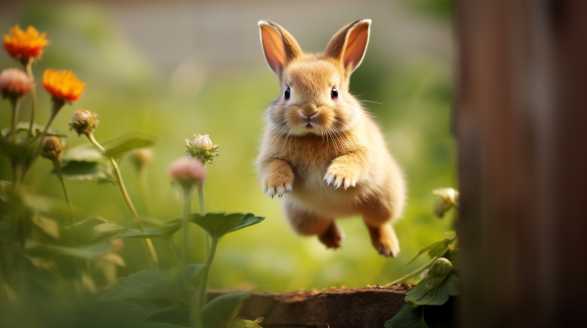
An Overview of Rabbit Jumping
Before we dive into the influence of size and weight on a rabbit’s jumping abilities, let’s take a moment to appreciate the sheer awesomeness of their leaps. Rabbits are natural-born jumpers, capable of launching themselves several times their own body length in a single bound.
The Role of Size in Jumping Abilities
Size does play a significant role in a rabbit’s jumping capabilities, although it might not be what you would expect. Contrary to popular belief, bigger doesn’t necessarily mean better when it comes to jumping.
Advantages of Being Small
- Enhanced Agility: Smaller rabbits have a shorter limb length, allowing them to swiftly change directions mid-jump. This agility grants them exceptional control, helping them navigate through obstacles effortlessly.
- Quick Acceleration: With less mass to propel, smaller rabbits can accelerate rapidly, resulting in swift and powerful jumps. This burst of acceleration gives them an edge in agility-driven activities like rabbit hopping competitions.
- Freer Movement: A smaller body size equates to fewer constraints, enabling rabbits to squeeze through tight spaces and explore various environments with ease. Their agility combined with their compactness allows them to jump into small burrows or leap across narrow crevices effortlessly.
Limitations of Being Small
While being small has its advantages, it does come with a few limitations:
- Reduced Jumping Height: Smaller rabbits’ overall height limitations can hinder them from reaching the same heights as larger rabbits. Their diminutive stature affects the length they can gain with each leap. However, don’t underestimate their ability to compensate with their agility!
- Inadequate Power: Due to their lower body weight, smaller rabbits may lack the power needed to overcome certain obstacles or jump across great distances. It’s essential to consider their size when assessing their capabilities in challenging jumping situations.
The Impact of Weight on Jumping Abilities
Now that we’ve explored the influence of size, let’s shift our focus to weight and its impact on a rabbit’s jumping abilities. Just like humans, rabbits come in various weights, and this factor can significantly affect their performance.
Effect of Weight on Jumping Distance
- Weightier Jumps: Heavier rabbits can generate more force with each jump, enabling them to cover greater distances. Their weight allows them to put more power into their leaps, propelling them forward effortlessly.
- Overcoming Resistance: When faced with obstacles such as tall grass or dense foliage, a heavier rabbit can power through with greater ease. The additional weight aids in overcoming resistance, facilitating seamless jumps even in challenging environments.
Effect of Weight on Jumping Height
- Limited Vertical Leap: While heavier rabbits excel at covering horizontal distances, their weight can limit their ability to jump to great heights. Gravity exerts a stronger downward force, making it more challenging for them to achieve impressive vertical leaps.
- Less Agility: The extra weight carried by larger rabbits can make them less agile, restricting their ability to navigate through intricate obstacles or change direction quickly during a jump.
Balancing Act: Size, Weight, and Skills
It’s vital to understand that the optimum physique for a rabbit’s jumping abilities is a delicate balance between size, weight, and agility.
Factors Affecting Jumping Abilities:
- Genetics: A rabbit’s genetic makeup plays a significant role in determining its size, weight, and overall physique. Certain breeds may be predisposed to excel at specific types of jumps, such as high jumps or long jumps.
- Age: Like any athlete, a rabbit’s jumping abilities may change over time. Younger rabbits generally possess more energy and flexibility, allowing them to jump higher and farther. As they age, their muscles may lose some elasticity, affecting their performance.
- Training: Skill development through proper training can enhance a rabbit’s jumping abilities, regardless of its size or weight. Regular practice and exposure to jumping exercises can improve their technique, timing, and overall fitness.
Celebrating Rabbits’ Impressive Leaping Abilities
Rabbits are truly extraordinary creatures, capable of performing incredible jumps that leave us in awe. While size and weight do influence their jumping abilities, agility and skill often prevail.
So, the next time you witness a rabbit’s extraordinary jump, marvel at the way their size, weight, and cleverness blend harmoniously, creating true hop-ortunities for a lifetime of leaps!
Conclusion
Wow, I can’t believe we’ve reached the end of this exciting rabbit jumping adventure! We’ve uncovered the secrets behind their incredible high jumps, explored the evolutionary advantages of their leaps, and delved into the fascinating science and mechanics behind their acrobatic abilities.
Just imagine being able to soar through the air like these fluffy creatures, defying gravity and reaching heights you never thought possible. It’s a world of excitement and wonder that truly captures the imagination.
These admirable abilities showcase the true survival skills of these furry marvels.
But rabbits not only jump for survival, they jump for fun too! From agility competitions to training in your own backyard, rabbits have become the stars of their very own furry Olympics.
It’s a joyous and awe-inspiring sight that brings a sense of wonder and enchantment.
So, I hope you’ve enjoyed this wild ride through the world of rabbit jumping. It’s a testament to the extraordinary abilities of these humble creatures and a reminder of the impressive wonders that nature has to offer.
It’s a sight that will surely leave you in awe.
Frequently Asked Questions
How high can rabbits jump?
Rabbits are capable of jumping heights of up to 3 feet or more. Although the ability to jump high varies among different breeds and individual rabbits, they are generally agile and powerful jumpers.
Can rabbits jump over fences?
Yes, rabbits can jump over fences, especially if the fence is not high enough. A typical backyard fence of 2 to 3 feet may not be sufficient to prevent a rabbit from escaping.
Is it common for rabbits to jump on furniture?
Rabbits are natural explorers and curious animals, so it is not uncommon for them to jump on furniture. However, whether or not a rabbit jumps on furniture depends on its individual personality and how it has been trained or acclimated to its environment.
Do rabbits jump to show signs of aggression?
No, rabbits do not typically jump to show signs of aggression. When rabbits are feeling threatened or anxious, they may exhibit aggressive behavior, such as lunging or biting, but jumping is not a common sign of aggression.
Can rabbits be trained not to jump on certain things?
Yes, rabbits can be trained not to jump on certain things, such as furniture or surfaces that are off-limits. Through consistent positive reinforcement training and the use of appropriate deterrents, rabbits can learn to respect boundaries and avoid jumping on prohibited areas.
Are there any health risks associated with rabbits jumping too high?
Jumping is a natural behavior for rabbits and, in moderation, poses no health risks. However, excessively high jumps or repeated jumping from high surfaces can potentially lead to injuries, such as sprains or fractures.
What can be done to prevent rabbits from jumping too high?
To prevent rabbits from jumping too high, it is crucial to provide them with ample mental and physical stimulation. This can include providing toys, tunnels, and other forms of enrichment to satisfy their natural instincts. Additionally, ensuring that the rabbit’s enclosure is appropriately sized and properly secured can help prevent excessive or dangerous jumping behavior.
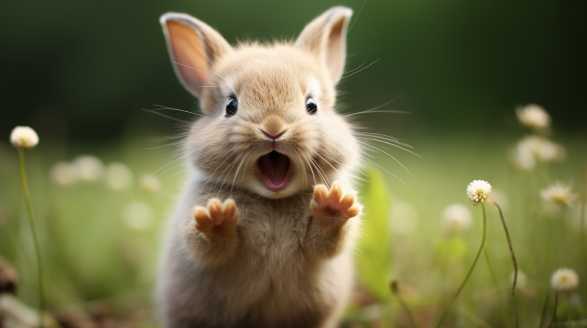
Why do Rabbits Poop So Much
Introduction Why do rabbits poop so much? Picture this: fluffy bunnies hopping around, so cute and adorable. But have you ever wondered why these furry creatures seem to be pooping machines? Well, my curious friends, I am here to unravel the mysteries and reveal the secrets behind a rabbit’s frequent pooping habits. From their unique […]
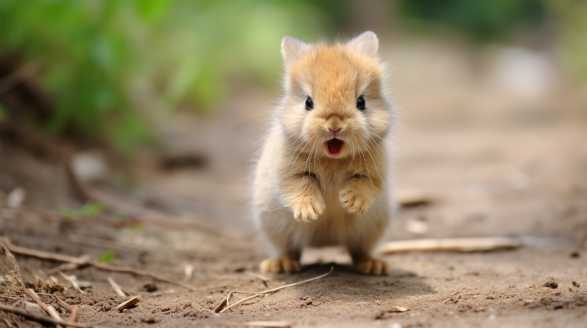
Are Rabbits Dangerous
Introduction Hey there, fellow animal lovers! Are you ready for an exciting adventure into the world of rabbits? But there’s so much more to them than meets the eye! Today, we’re going to dive deep into the behavior, potential dangers, and ways to create a safe environment for rabbits and their human companions. From their […]
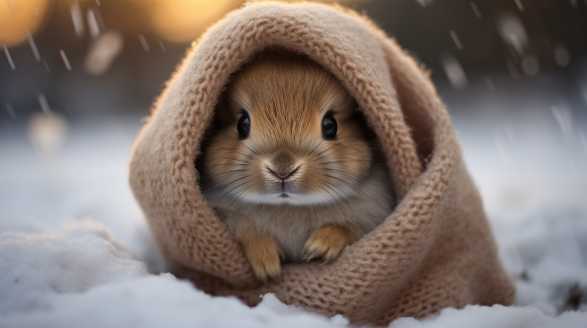
How To Keep Rabbits Warm in The Winter
Introduction Hey there, fellow rabbit lovers! Winter is just around the corner, and as responsible bunny owners, it’s essential for us to ensure the well-being and comfort of our adorable companions. Winter can be a bit challenging for rabbits, who are sensitive creatures that require extra care to thrive in low temperatures. From managing humidity […]
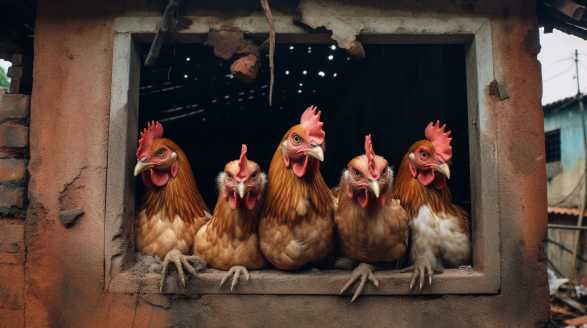
Can Rabbits And Chickens Live Together
Introduction Can rabbits and chickens live together? Let’s find out. Imagine fluffy bunnies with their twitching noses and soft fur, quietly hopping along as chickens joyfully cluck and peck at the ground. It’s like a scene right out of a storybook! But, of course, it’s not all rainbows and sunshine. Keeping rabbits and chickens together […]
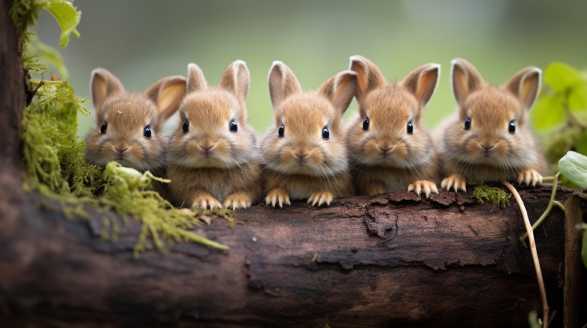
How Many Babies Do Rabbits Have
Introduction Hey there, rabbit enthusiasts! Are you ready to dive into the enchanting world of rabbits and explore their extraordinary reproductive abilities? we will unravel the mysteries behind the rapid breeding capabilities of rabbits and discover the secrets behind their impressive population growth. From the basics of rabbit reproduction to the unique traits of different […]
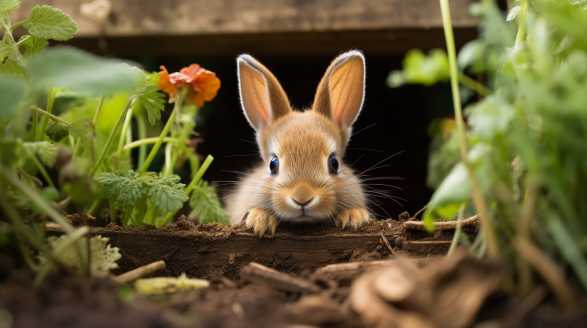
How To Keep Rabbits Out Of Garden
Introduction How to keep rabbits out of garden? Let’d find out. Imagine this – you’ve poured your heart and soul into creating the most picture-perfect garden. The flowers are in full bloom, the vegetables are thriving, and there’s an air of serenity as you bask in the beauty of your hard work. But fear not, […]
